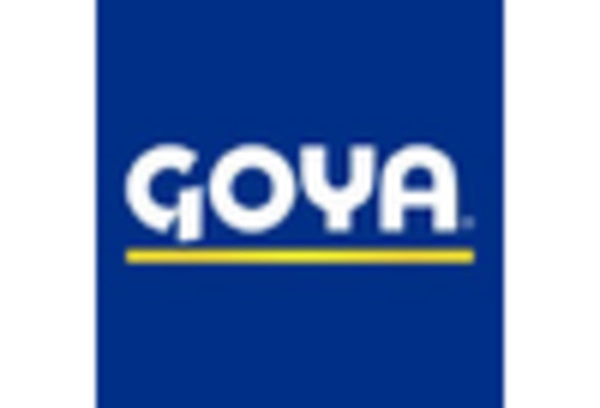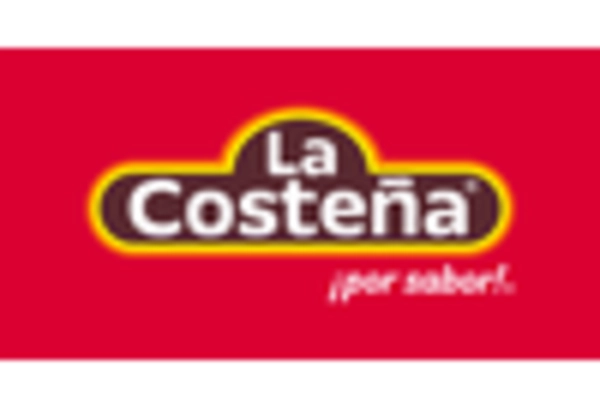The Hispanic Foods Market is currently characterized by a dynamic competitive landscape, driven by increasing consumer demand for authentic flavors and convenience. Key players such as Gruma (MX), Goya Foods (US), and Hormel Foods (US) are strategically positioned to leverage these trends. Gruma (MX), known for its tortilla production, has focused on innovation in product offerings, particularly in the realm of healthier options, which aligns with the growing consumer preference for nutritious foods. Goya Foods (US) has emphasized regional expansion, enhancing its distribution networks to reach a broader audience, while Hormel Foods (US) has pursued digital transformation initiatives to streamline operations and improve customer engagement. Collectively, these strategies contribute to a competitive environment that is increasingly focused on meeting diverse consumer needs through innovation and accessibility.
In terms of business tactics, companies are increasingly localizing manufacturing to reduce supply chain vulnerabilities and enhance responsiveness to market demands. The Hispanic Foods Market appears moderately fragmented, with a mix of large multinational corporations and smaller regional players. This structure allows for a variety of product offerings, yet the influence of key players remains substantial, as they set trends and standards that smaller companies often follow.
In August 2025, Goya Foods (US) announced a partnership with a major grocery chain to launch a new line of organic products aimed at health-conscious consumers. This strategic move not only expands Goya's product portfolio but also positions the company to capture a growing segment of the market that prioritizes organic and sustainable food options. The partnership is likely to enhance Goya's visibility and accessibility, further solidifying its market presence.
In September 2025, Hormel Foods (US) unveiled a new digital platform designed to enhance customer interaction and streamline the purchasing process for its Hispanic food products. This initiative reflects a broader trend towards digitalization within the food industry, suggesting that Hormel is keen on leveraging technology to improve customer experience and operational efficiency. The platform may also facilitate better data collection, allowing Hormel to tailor its offerings more effectively to consumer preferences.
In July 2025, Gruma (MX) expanded its production capabilities by investing in a new facility in the United States, aimed at increasing its output of gluten-free tortillas. This expansion not only demonstrates Gruma's commitment to meeting the rising demand for gluten-free products but also indicates a strategic move to enhance its competitive edge in the North American market. By increasing local production, Gruma may reduce shipping costs and improve supply chain reliability, which is crucial in today's market.
As of October 2025, the competitive trends within the Hispanic Foods Market are increasingly defined by digitalization, sustainability, and the integration of artificial intelligence in operations. Strategic alliances are becoming more prevalent, as companies recognize the value of collaboration in enhancing product offerings and market reach. Looking ahead, competitive differentiation is likely to evolve from traditional price-based competition towards a focus on innovation, technological advancements, and supply chain reliability, as companies strive to meet the ever-changing demands of consumers.


















Leave a Comment